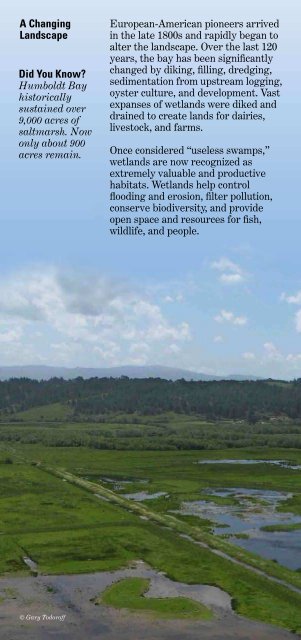Humboldt Bay - U.S. Fish and Wildlife Service
Humboldt Bay - U.S. Fish and Wildlife Service
Humboldt Bay - U.S. Fish and Wildlife Service
Create successful ePaper yourself
Turn your PDF publications into a flip-book with our unique Google optimized e-Paper software.
A Changing<br />
L<strong>and</strong>scape<br />
Did You Know?<br />
<strong>Humboldt</strong> <strong>Bay</strong><br />
historically<br />
sustained over<br />
9,000 acres of<br />
saltmarsh. Now<br />
only about 900<br />
acres remain.<br />
© Gary Todoroff<br />
European-American pioneers arrived<br />
in the late 1800s <strong>and</strong> rapidly began to<br />
alter the l<strong>and</strong>scape. Over the last 120<br />
years, the bay has been signifcantly<br />
changed by diking, flling, dredging,<br />
sedimentation from upstream logging,<br />
oyster culture, <strong>and</strong> development. Vast<br />
expanses of wetl<strong>and</strong>s were diked <strong>and</strong><br />
drained to create l<strong>and</strong>s for dairies,<br />
livestock, <strong>and</strong> farms.<br />
Once considered “useless swamps,”<br />
wetl<strong>and</strong>s are now recognized as<br />
extremely valuable <strong>and</strong> productive<br />
habitats. Wetl<strong>and</strong>s help control<br />
fooding <strong>and</strong> erosion, flter pollution,<br />
conserve biodiversity, <strong>and</strong> provide<br />
open space <strong>and</strong> resources for fsh,<br />
wildlife, <strong>and</strong> people.<br />
A Unique<br />
Diversity of<br />
Habitats<br />
Red-legged Frog<br />
© Jamie Bettaso<br />
<strong>Humboldt</strong> <strong>Bay</strong><br />
Owl’s Clover<br />
© Andrea Pickart<br />
<strong>Humboldt</strong> <strong>Bay</strong> NWR<br />
In 1971, the refuge was established<br />
to conserve precious habitat for the<br />
great diversity of birds, mammals,<br />
fsh, amphibians, invertebrates, <strong>and</strong><br />
plants that occur in the <strong>Humboldt</strong><br />
<strong>Bay</strong> area. The<br />
refuge has several<br />
different units<br />
totalling almost<br />
4,000 acres. These<br />
units consist<br />
of a mosaic<br />
of mudfats,<br />
estuarine eelgrass<br />
meadows,<br />
saltmarsh,<br />
brackish marsh,<br />
seasonally<br />
Great Blue Heron<br />
© Gary Kramer<br />
fooded freshwater wetl<strong>and</strong>s, riparian<br />
wetl<strong>and</strong>s, streams, coastal dunes, <strong>and</strong><br />
forest. These habitats support over<br />
316 species of birds <strong>and</strong> 40 species of<br />
mammals. The refuge also provides<br />
habitat for approximately 100 species<br />
of fsh <strong>and</strong> marine invertebrates,<br />
many of which contribute to sport<br />
or commercial fsheries, including<br />
steelhead, coho <strong>and</strong> chinook salmon,<br />
<strong>and</strong> Dungeness crab.

















